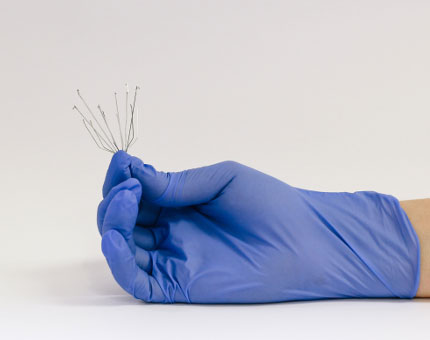For more than two decades a device, known as the inferior vena cava filter (pictured below), has been routinely inserted into trauma patients in a bid to prevent clots that might form in their legs from migrating to their lungs (the results of which can be fatal).
It’s an invasive and expensive procedure and, until now, its efficacy has been unknown. Debates about whether inserting them into every trauma patient is the best course of action have dominated medical agendas since the filters became widely available. Thanks to a landmark Australian study that’s been published in The New England Journal of Medicine, clinicians at the coal face of trauma care finally know when, and on whom, this type of device should be used.
WA researchers – led by Royal Perth Hospital intensivist Dr Kwok Ming Ho – found that there was no significant benefit to the intervention being provided in the initial days following injury, and that insertion of the device was unnecessary for most trauma patients. The researchers’ findings were based on a randomised controlled trial of 240 severely injured patients admitted to Royal Perth and Sir Charles Gairdner hospitals in Western Australia and the Royal Brisbane and Women’s Hospital in Queensland.
The study showed that having a filter inserted within the 72 hours following injury, did not significantly alter patients’ risk of either having a pulmonary embolism or of dying. “We acknowledge that there is a very real need to reduce patients’ risk of developing blood clots following a major injury, but our research shows that routine early deployment of these filters is not the solution,” Dr Ho said. “Instead, the use of a filter should be reserved for those patients who are having bleeding problems or who remain at high risk of bleeding for at least a week after their severe injury.” Dr Ho said that when considered alongside the costs and potential risks associated with the invasive nature of the device, it was clear that the filter should not be used routinely.
Injured patients are at greater risk of blood clots due to a variety of mechanisms including immobility and possible damage to blood vessels and tissue.
The inferior vena cava is the largest vein in the abdomen and the filter is fed into it through a vein in the groin.

WA’s Chief Medical Officer, Dr Michael Levitt said the findings were an example of some of the excellent research being undertaken by clinician researchers in Western Australia’s public health system. “This is an important study that will simplify the treatment of trauma patients around the world by guiding clinicians on the specific circumstances in which these devices should and should not be used,” Dr Levitt said. Dr Ho was supported to undertake the research by a Department of Health/Raine Medical Research Foundation Clinician Research Fellowship, a State Government Research Translation Project grant and the RPH Research Foundation Trauma Research Program. Other WA Health members of the research team included Sudhakar Rao, Stephen Honeybul (pictured above with Dr Ho), Rene Zellweger, Bradley Wibrow, Alan Kop, Tomas Corcoran, Philip Misur, Cyrus Edibam, Jenny Chamberlain and Claire Forsdyke.
This trial was conducted in collaboration with Professor Ross Baker from Murdoch University, Professor Jeffrey Lipman and Dr Anthony Holley from the University of Queensland, Professor Frederick Rogers from the University of Pennsylvania, and Professor Elizabeth Geelhoed from The University of Western Australia.